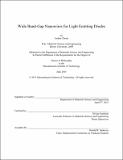| dc.contributor.advisor | Silvija Gradečak | en_US |
| dc.contributor.author | Chesin, Jordan (Jordan Paul) | en_US |
| dc.contributor.other | Massachusetts Institute of Technology. Department of Materials Science and Engineering. | en_US |
| dc.date.accessioned | 2015-09-17T17:44:11Z | |
| dc.date.available | 2015-09-17T17:44:11Z | |
| dc.date.copyright | 2015 | en_US |
| dc.date.issued | 2015 | en_US |
| dc.identifier.uri | http://hdl.handle.net/1721.1/98581 | |
| dc.description | Thesis: Ph. D., Massachusetts Institute of Technology, Department of Materials Science and Engineering, 2015. | en_US |
| dc.description | This electronic version was submitted by the student author. The certified thesis is available in the Institute Archives and Special Collections. | en_US |
| dc.description | Cataloged from student-submitted PDF version of thesis. | en_US |
| dc.description | Includes bibliographical references (pages 133-147). | en_US |
| dc.description.abstract | Wide band-gap nanowires composed of GaN and ZnO are promising materials for unique designs and potential efficiency improvement of light emitting diodes (LEDs) for solid state lighting. The large surface-to-volume ratio of nanowires provides facile strain-relaxation such that nanowires can be grown on substrates with a large lattice mismatch and remain free of threading dislocations. Specifically, the growth of wide band-gap nanowires directly on Si substrates is a promising platform for the fabrication of wafer-scale nanowire array-based LEDs. While nanowire-based LEDs have been previously demonstrated, there has been no work directly comparing the different potential designs of nanowire-based LEDs addressing how material-specific properties affect the light extraction and internal quantum efficiency (IQE). Furthermore, for scalable fabrication of nanowire array-based LEDs on Si a large degree of control over the nanowire synthesis is necessary, especially with regard to the nanowire length uniformity, vertical alignment relative to the growth substrate and the nanowire areal density. In this work we directly compare feasible designs for GaN-InGaN nanowire-based LEDs using a combination of photonic simulation and modeling. We compared the directed external quantum efficiency of III-nitride LEDs on silicon based on axial and radial nanowire heterostructures, considering m- and c-directional nanowires. The directed extraction efficiency was calculated using photonic simulations and the IQE was estimated using the A-B-C model. We found that m-directional axial heterostructures have the highest directed extraction efficiency, due to the strong polarization anisotropy of III-nitrides, and display similar IQE as c-directional axial heterostructures. By combining IQE and directed extraction, a range of expected directed external quantum efficiencies (EQEs) reveal that m-directional axial heterostructures have EQEs up to three times that of c-directional axial heterostructures, providing guidelines for the design of future III-nitride nanowire-based LEDs. While III-nitride nanowires are promising candidates, ZnO is an alternative with a higher exciton binding energy and excellent optical properties. To create a platform for the fabrication of ZnO nanowire array-based LEDs on Si, the growth of ZnO was investigated primarily using ZnO solution-processed seed-layers in vapor transport and condensation growth at high temperatures. Due to dependency of the carbothermal reduction of ZnO powder, which acts as the precursor source in the growth, the nanowire areal density was dependent on O2 flow. At low nanowire areal density, growth proceeded in a regime in which continuous nucleation of nanowires occurred throughout the growth, resulting in nanowires with a fixed aspect ratio, but widely varying lengths. At higher nanowire areal densities, the nanowires competed for source precursors in a surface-diffusion limited regime of growth in which the growth rate was dependent upon the nanowire diameter. We observed a critical nucleation diameter for nanowires in the continuous-nucleation regime, which was higher at lower oxygen flow rates. Thus, to achieve length uniformity we developed a two-stage growth method in which nanowires are nucleated at low oxygen flow in the continuous nucleation regime to set the nanowire diameter. In the second stage of growth, where conditions were shifted to the surface-diffusion limited regime, the large diameters set by the first stage of growth were designed to be in the range at which the growth rate does not vary substantially with diameter. The concept of this approach was extended to include control over the nanowire areal density, using sparse ZnO seed-layers. These ZnO nanowires retain excellent optical properties and we observed both demonstrative ptype and n-type doping, dependent on processing conditions, using individual nanowire electrical characterization. Thus, by achieving ZnO nanowire arrays with controlled nanowire areal density, excellent length uniformity and vertical alignment relative to the substrate, we have demonstrated a promising platform for the fabrication of scalable ZnO nanowire array-based LEDs. | en_US |
| dc.description.statementofresponsibility | by Jordan Chesin. | en_US |
| dc.format.extent | 155 pages | en_US |
| dc.language.iso | eng | en_US |
| dc.publisher | Massachusetts Institute of Technology | en_US |
| dc.rights | M.I.T. theses are protected by copyright. They may be viewed from this source for any purpose, but reproduction or distribution in any format is prohibited without written permission. See provided URL for inquiries about permission. | en_US |
| dc.rights.uri | http://dspace.mit.edu/handle/1721.1/7582 | en_US |
| dc.subject | Materials Science and Engineering. | en_US |
| dc.title | Wide band-gap nanowires for light emitting diodes | en_US |
| dc.title.alternative | Wide band-gap nanowires for LEDs | en_US |
| dc.type | Thesis | en_US |
| dc.description.degree | Ph. D. | en_US |
| dc.contributor.department | Massachusetts Institute of Technology. Department of Materials Science and Engineering | |
| dc.identifier.oclc | 920883210 | en_US |
